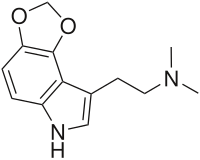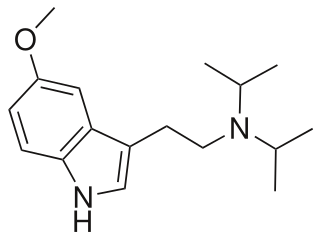
5-Methoxy-N,N-diisopropyltryptamine is a psychedelic tryptamine and the methoxy derivative of diisopropyltryptamine (DiPT).

Diisopropyltryptamine is a psychedelic hallucinogenic drug of the tryptamine family that has a unique effect. While the majority of hallucinogens affect the visual sense, DiPT is primarily aural.

5-MeO-MiPT is a psychedelic and hallucinogenic drug, used by some as an entheogen. It has structural and pharmacodynamic properties similar to the drugs 5-MeO-DiPT, DiPT, and MiPT. It is commonly used as a "substitute" for 5-MeO-DiPT because of the very similar structure and effects.

5-MeO-DET or 5-methoxy-N,N-diethyltryptamine is a hallucinogenic tryptamine.

4-HO-MiPT is a synthetic substituted aromatic compound and a lesser-known psychedelic tryptamine. It is thought to be a serotonergic psychedelic, similar to magic mushrooms, LSD and mescaline. Its molecular structure and pharmacological effects somewhat resemble those of the tryptamine psilocin, which is the primary psychoactive chemical in magic mushrooms.

N-Methyl-N-isopropyltryptamine (MiPT) is a psychedelic tryptamine, closely related to DMT, DiPT and Miprocin.

5-MeO-DPT, is a psychedelic and entheogenic designer drug.

Ethylisopropyltryptamine (EiPT) is a chemical of the tryptamine family that and produces psychedelic and hallucinogenic effects. It was probably first synthesized by American psychopharmacologist, Alexander Shulgin.

2,N,N-trimethyltryptamine, 2,N,N-TMT, or 2-Me-DMT is a tryptamine derivative that is a psychedelic drug. It was invented by Alexander Shulgin and reported in his book TiHKAL (#34). It is claimed to show psychoactive effects at a dosage of 50–100 mg orally, but these are relatively mild compared to other similar drugs, suggesting that while the 2-methyl group has blocked the binding of metabolic enzymes, it is also interfering with binding to the 5HT2A receptor target that mediates the hallucinogenic effects of these drugs.

3,4-Methylenedioxy-N-propylamphetamine is a lesser-known psychedelic drug and a substituted amphetamine. MDPR was first synthesized by Alexander Shulgin. In his book PiHKAL, the minimum dosage is listed as 200 mg, and the duration unknown. MDPR is a promoter; by itself it has almost no effects on the mind, but it promotes the effects of hallucinogens, similarly to the closely related MDPH.

4-MeO-MiPT, or 4-methoxy-N-methyl-N-isopropyltryptamine, is a lesser-known psychedelic drug. It is the 4-methoxy analog of MiPT. 4-MeO-MiPT was first synthesized by Alexander Shulgin and is mentioned in his book TiHKAL. Subsequent testing by Shulgin on human test subjects showed the effective dose as 20-30 mg ; the onset time between ingestion and the first noticeable effects was 45-60 min, with sensations lasting between 2-2.5 hours. The sensation were significantly milder than those of 4-HO-MiPT, with 4-MeO-MiPT producing erotic-enhancing effects, and few of the visuals common with tryptamines. Very little data exists about the pharmacological properties, metabolism, and toxicity of 4-MeO-MiPT.
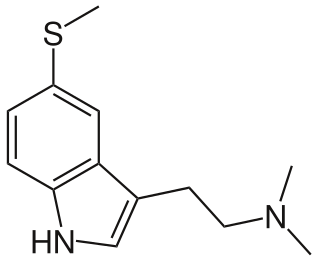
5-MeS-DMT (5-methylthio-N,N-dimethyltryptamine) is a lesser-known psychedelic drug. It is the 5-methylthio analog of dimethyltryptamine (DMT). 5-MeS-DMT was first synthesized by Alexander Shulgin. In his book TiHKAL, the minimum dosage is listed as 15-30 mg. The duration listed as very short, just like DMT. 5-MeS-DMT produces similar effects to DMT, but weaker. Shulgin describes his feelings while on a low dose of this drug as "pointlessly stoned", although at a higher dose of 20 mg he says it is "quite intense" and suggests that a higher dose still might have full activity.
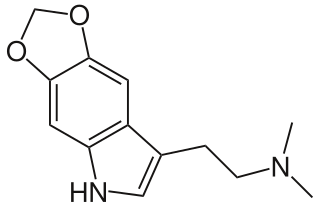
5,6-MDO-DMT, or 5,6-methylenedioxy-N,N-dimethyltryptamine, is a lesser-known psychedelic drug. It is the 5,6-methylenedioxy analog of DMT. 5,6-MDO-DMT was first synthesized by Alexander Shulgin. In his book TiHKAL, 5,6-MDO-DMT produces no noticeable psychoactive effects, although it was only tested up to a dose of 5 mg. Very little data exists about the pharmacological properties, metabolism, and toxicity of 5,6-MDO-DMT.
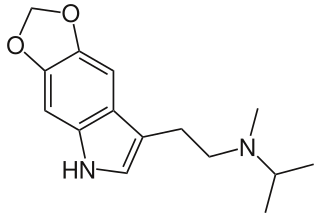
5,6-MDO-MiPT, or 5,6-methylenedioxy-N-methyl-N-isopropyltryptamine, is a lesser-known psychedelic drug. It is the 5,6-methylenedioxy analog of MiPT. 5,6-MDO-MiPT was first synthesized by Alexander Shulgin. In his book TiHKAL, 5,6-MDO-MiPT produces slight paresthesia at low doses. Very little data exists about the pharmacological properties, metabolism, and toxicity of 5,6-MDO-MiPT.
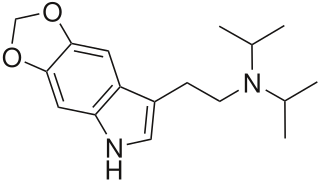
5,6-MDO-DiPT, or 5,6-methylenedioxy-N,N-diisopropyltryptamine, is a lesser-known psychedelic drug. It is the 5,6-methylenedioxy analog of DiPT. 5,6-MDO-DiPT was first synthesized by Alexander Shulgin. It is mentioned in his book TiHKAL, but 5,6-MDO-DiPT was never tested to determine what effects it produces, if any. Very little data exists about the pharmacological properties, metabolism, and toxicity of 5,6-MDO-DiPT.

4,5-MDO-DiPT, or 4,5-methylenedioxy-N,N-diisopropyltryptamine, is a lesser-known psychedelic drug. It is the 4,5-methylenedioxy analog of DiPT. 4,5-MDO-DiPT was first synthesized by Alexander Shulgin. In his book TiHKAL, 4,5-MDO-DiPT produces slight LSD-like effects after several hours. Very little data exists about the pharmacological properties, metabolism, and toxicity of 4,5-MDO-DiPT.
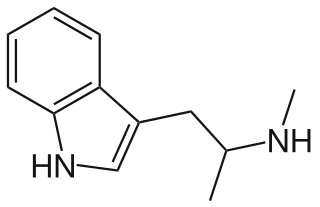
Alpha,N-DMT, or α,N-dimethyltryptamine, is a lesser-known psychedelic drug. It is the α,N-dimethyl analog of DMT. α,N-DMT was first synthesized by Alexander Shulgin. In his book TiHKAL, Shulgin lists the dosage as 50-100 mg, and the duration as 6–8 hours. α,N-DMT causes an unpleasant body load. Very little data exists about the pharmacological properties, metabolism, and toxicity of α,N-DMT. α,N-DMT is known to be a potent monoamine oxidase inhibitor
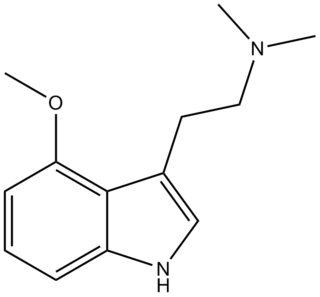
4-MeO-DMT (4-methoxy-N,N-dimethyltryptamine) is a tryptamine derivative which has some central activity in animal tests similar to that of related psychedelic tryptamine drugs, although with significantly lower potency than either 5-MeO-DMT or 4-hydroxy-DMT (psilocin).

1-(2-Dimethylaminoethyl)dihydropyrano(3,2-e)indole (4,5-DHP-DMT) is a tricyclic tryptamine derivative which acts as a potent and reasonably selective partial agonist for the serotonin receptor 5-HT2A, with a Ki of 17.0 nM, and moderate selectivity over related serotonin receptors. It has lower 5-HT2 affinity and efficacy than the related compound AL-37350A, but higher lipophilicity.
